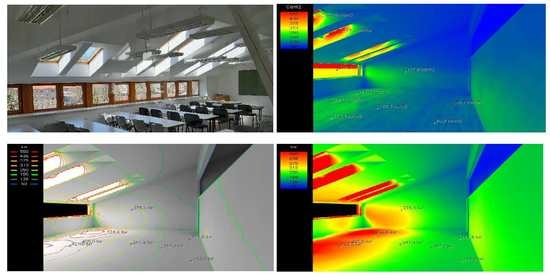Influence of Roof Windows Area Changes on the Classroom Indoor Climate in the Attic Space: A Case Study
Abstract
:1. Introduction
- ▪ Better utilization of daylight accompanied with proper management;
- ▪ Regular cleaning of windows and bulbs from dust; this can save energy in light;
- ▪ Incorrect lamp maintenance can absorb up to 50% of light through a thick layer of dust;
- ▪ When leaving the room, the last obligation is always to turn off the light.
2. Materials and Methods
- ▪ Measurement of daylight value, Daylight Factor;
- ▪ Prediction of summer overheating;
- ▪ Calculated on the basis of simulation tools based on measured or predicted data;
- ▪ Search for optimization of indoor light and thermal climate.
2.1. Daylight Metrics
- —is the global external horizontal illuminance [lx];
- —is the direct external illuminance, recalculated on the horizontal plane [lx];
- —is the diffuse external horizontal illuminance [lx].
- —is the extraterrestrial illuminance expressed on the horizontal plane [lx];
- —is the luminous extinction coefficient [-];
- —is the optical relative air mass of the atmosphere [-];
- —is the luminous turbidity factor (TV = 4 representing ISO/CIE Type 12 clear sky standard conditions and the environment in common cities areas).
- —is the factor of light transmission at angle from the window normal [-];
- —is the factor of light transmission in normal direction [-];
- —is the factor of dirt reduction for the outer side of the glass [-];
- —is the factor of dirt reduction for the inner side of the glass [-].
- —is luminous flux [lm];
- —is area [m2].
- Einternal—illuminance of internal horizontal plane (lx);
- Eexternal—illuminance of external horizontal plane (lx).
- DFmin—is minimum of daylight factor [%],
- DFaverage—is average value of daylight factor [%].
- AWINDOW—is area of windows [m2];
- AFLOOR—is area of floor [m2];
- AWALL—is area of walls [m2].
2.2. Summer Overheating
- In summer—from + 24 to 28 °C;
- In winter—from + 22 to 24 °C.
- —is the volume of infiltrated air [m3 /s];
- —is the effective area of the orifice through which air can flow [m2];
- ct and cv are the outflow factors for the pressure difference caused by gravity and wind.
- -
- The air temperature changes relatively slowly, rarely rising or falling by more than a few degrees in an hour;
- -
- In the case of sunlight, large and rapid changes in values can occur within a few minutes. This is due to the very sensitive connection to cloudy skies;
- -
- The wind speed can take on multiple values in a few minutes. The record of this quantity is very variable, although it is possible to notice a certain character of increase or decrease during the day. Simplifying such a course of climatic factors into hourly values requires aggregation, which must necessarily omit a large number of sometimes very different records.
- —is opening time of windows [h];
- —is outside air temperature [°C].
3. Case Study—Classroom in Attic of School Building
3.1. Context
3.2. Daylight Rating
3.3. Daylight Measurement and Daylight Simulation
3.4. Prediction of Indoor Climate in Summer Period
4. Discussion
5. Conclusions
Author Contributions
Funding
Acknowledgments
Conflicts of Interest
References
- Mohapatra, B.N.; Kumar, M.R.; Mandal, S.K. Analysis of daylighting using daylight factor and luminance for different room scenarios. Int. J. Civ. Eng. Technol. 2018, 9, 949–960. Available online: http://www.iaeme.com/IJCIET/index.asp (accessed on 10 March 2020).
- Tanner, C.K. Effect of school design on student outcomes. J. Educ. Adm. 2009, 47, 381–399. [Google Scholar] [CrossRef]
- Abdelatia, B.; Marenne, C.H.; Semidor, C. Daylighting strategy for sustainable schools: Case study of prototype classroom in Libya. J. Sustain. Dev. 2010, 3, 60–68. [Google Scholar] [CrossRef] [Green Version]
- Li, D.H.W. A review of daylight illuminance determinations and energy implications. Appl. Energy 2010, 87, 2109–2118. [Google Scholar] [CrossRef]
- Constanzo, V.; Evola, G.; Marletta, L. A review of daylighting strategies in schools: State of the art and expected future trends. Buildings 2017, 7, 41. [Google Scholar] [CrossRef] [Green Version]
- Read, A. Integration of daylighting into educational (school) building design for energy efficiency, health benefit, and mercury emissions reduction using heliodor for physical modeling. Master’s Thesis, Rochester Institute of Technology, Rochester, NY, USA, 2017. Available online: http://scholarworks.rit.edu/cgi/viewcontent.cgi?article=10826&context=theses (accessed on 15 March 2020).
- Katunský, D.; Zozulák, M.; Kondáš, K.; Šimiček, J. Numerical analysis and measurement results of a window sill. In Advanced Materials Research; book series; Trans Tech Publications Ltd.: Zurich, Switzerland, 2014; Volume 899, pp. 147–150. [Google Scholar] [CrossRef]
- Katunský, D.; Zozulák, M.; Vertaľ, M.; Šimiček, J. Experimentally Measured Boundary and Initial Conditions for Simulations. In Advanced Materials Research; book series; Trans Tech Publications Ltd.: Zurich, Switzerland, 2014; Volume 1041, pp. 293–296. [Google Scholar] [CrossRef]
- Heschong, L.; Wright, R.L.; Okura, S. Daylighting impacts on Human performance in school. J. Illum. Eng. Soc. 2013, 31, 101–114. [Google Scholar] [CrossRef]
- Nicklas, M.H.; Bailey, G.B. Daylighting in schools: Energy costs reduced student performance improved. Strateg. Plan. Energy Environ. 2012, 17, 41–61. [Google Scholar] [CrossRef]
- Yang, G.; Yonghong, Y. Daylighting design in classroom based on yearly-graphic analysis. Sustainability 2016, 8, 604. [Google Scholar] [CrossRef] [Green Version]
- Reinhart, C.H.; Fitz, A. Findings from a survey on the current use of daylight simulations in building design. Energy Build. 2006, 38, 824–835. [Google Scholar] [CrossRef] [Green Version]
- Edwards, L.; Torcellini, P. Literature review of the effects of natural light on building occupants; Technical Report; National Renewable Energy Laboratory: Golden, CO, USA, 2002; pp. 17–26. [Google Scholar] [CrossRef] [Green Version]
- Nocera, F.; Faro, L.A.; Constanzo, V.; Raciti, C.H. Daylight performance of classrooms in a mediterranean school heritage building. Sustainability 2018, 10, 3705. [Google Scholar] [CrossRef] [Green Version]
- Daylight with roof windows, fat-roof windows and modular skylights. Available online: www.velux.com (accessed on 10 March 2020).
- STN 730580. Daylighting in Buildings, Part–1 Basic Requirements, 1986 Part–2; Daylighting of Residential Buildings; Slovak Republic Office of Standards, Metrology and Testing: Bratislava, Slovakia, 2000. [Google Scholar]
- EN 12464-1:2012. Light and Lighting; Lighting of Work Places-Part 1: Indoor Work Places; Slovak Republic Office of Standards, Metrology and Testing: Bratislava, Slovakia, 2012. [Google Scholar]
- Kuhlenengel, M.; Waters, C.E.; Konstantzos, I. Assessing the impact of outside view on learning: A close look to EN 17037 ‘view out’practices through the analysis of 220 classrooms. In Journal of Physics: Conference Series; IOP Publishing: Bristol, UK, 2019; Volume 1343, p. 012159. [Google Scholar]
- Tureková, I.; Lukáčová, D.; Bánesz, G. Quality Assessment of the University Classroom Lighting-A Case Study. TEM J. 2018, 7, 829–836. [Google Scholar]
- Mathalamuthu, A.D.; Ibrahim, N.L.N.; Ponniah, V.; Shafiei, M.W.M.; Ismail, R. Illuminance Uniformity Using Public Works Department (PWD) Standard Design for Public Schools Classroom Design in Malaysia. J. Adv. Res. Fluid Mech. Therm. Sci. 2018, 52, 205–214. [Google Scholar]
- Irnawaty, I.; Rahim, M.R.; Hamzah, B.; Jamala, N. Daylight intensity analysis of secondary school buildings for environmental development. In IOP Conference Series: Earth and Environmental Science; IOP Publishing: Bristol, UK, 2019; Volume 382, p. 012022. [Google Scholar]
- Ashrafian, T.; Moazzen, N. The impact of glazing ratio and window configuration on occupants’ comfort and energy demand: The case study of a school building in Eskisehir, Turkey. Sustain. Cities Soc. 2019, 47, 101483. [Google Scholar] [CrossRef]
- Qahtan, A.M. Daylight Illuminance in Classrooms Adjacent to Covered and Uncovered Courtyards Under The Clear Sky of Najran City, Saudi Arabia. Emir. J. Eng. Res. 2019, 24, 4. Available online: https://scholarworks.uaeu.ac.ae/ejer/vol24/iss4/4 (accessed on 12 March 2020).
- Lourenço, P.; Pinheiro, M.D.; Heitor, T. Light use patterns in Portuguese school buildings: User comfort perception, behaviour and impacts on energy consumption. J. Clean. Prod. 2019, 228, 990–1010. [Google Scholar] [CrossRef]
- Kwon, C.H.W.; Kang, J.L. Integrated Daylighting Design by Combining Passive Method with DaySim in a Classroom. Energies 2018, 11, 3168. [Google Scholar] [CrossRef] [Green Version]
- Cabeza-Lainez, J.; Almodovar-Melendo, J.M.; Dominguez, I. Daylight and Architectural Simulation of the Egebjerg School (Denmark): Sustainable Features of a New Type of Skylight. Sustainability 2019, 11, 5878. [Google Scholar] [CrossRef] [Green Version]
- Rubiera, E.L.G.; Torija, J.G.S.; Frutos, C.B. Zero cost conditioning techniques to improve the indoor environment of school buildings. Rev. Construcción 2019, 18, 525–535. [Google Scholar] [CrossRef]
- Costanzo, V.; Evola, G.; Marletta, L.; Pistone Nascone, F. Application of climate based daylight modelling to the refurbishment of a school building in Sicily. Sustainability 2018, 10, 2653. [Google Scholar] [CrossRef] [Green Version]
- Galal, K.S. The impact of classroom orientation on daylight and heat-gain performance in the Lebanese Coastal zone. Alex. Eng. J. 2019, 58, 827–839. [Google Scholar] [CrossRef]
- Fang, Y.; Cho, S. Design optimization of building geometry and fenestration for daylighting and energy performance. Sol. Energy 2019, 191, 7–18. [Google Scholar] [CrossRef]
- Brembilla, E.; Chi, D.A.; Hopfe, C.J.; Mardaljevic, J. Evaluation of climate-based daylighting techniques for complex fenestration and shading systems. Energy Build. 2019, 203, 109454. [Google Scholar] [CrossRef]
- Lassandro, P.; Zonno, M. A work-related learning project for energy efficiency evaluation and indoor comfort of school buildings. Ing. Syst. d’Information 2018, 23, 7–27. [Google Scholar] [CrossRef]
- Tanić, M.; Stanković, D.; Kondić, S.; Kankhva, V. Principles and Implementation of Daylighting Systems in Classrooms. In Energy Management of Municipal Transportation Facilities and Transport; Springer: Cham, Switzerland, 2018; pp. 720–731. [Google Scholar] [CrossRef]
- Zhong, L.; Yuan, J.; Fleck, B. Indoor Environmental Quality Evaluation of Lecture Classrooms in an Institutional Building in a Cold Climate. Sustainability 2019, 11, 6591. [Google Scholar] [CrossRef] [Green Version]
- Dagli, A.; Gençdal, G. The Relationship between Physical Conditions of School Buildings and Organizational Commitment According to Teachers’ Perceptions. World J. Educ. 2019, 9, 166–180. [Google Scholar] [CrossRef]
- Bluyssen, P.M.; Zhang, D.; Kurvers, S.; Overtoom, M.; Ortiz-Sanchez, M. Self-reported health and comfort of school children in 54 classrooms of 21 Dutch school buildings. Build. Environ. 2018, 138, 106–123. [Google Scholar] [CrossRef]
- Saraiva, T.S.; Silva, E.M.; Almeida, M.; Bragança, L. Comparative study of comfort indicators for school constructions in sustainability methodologies: Schools in the Amazon and the southeast region of Brazil. Sustainability 2019, 11, 5216. [Google Scholar] [CrossRef] [Green Version]
- Abdelhakim, M.; Lim, Y.W.; Kandar, M.Z. Optimum Glazing Configurations for Visual Performance in Algerian Classrooms under Mediterranean Climate. J. Daylighting 2019, 6, 11–22. [Google Scholar] [CrossRef]
- Ma’bdeh, S.; Al-Khatatbeh, B. Daylighting Retrofit Methods as a Tool for Enhancing Daylight Provision in Existing Educational Spaces—A Case Study. Buildings 2019, 9, 159. [Google Scholar] [CrossRef] [Green Version]
- Seyedolhosseini, A.; Masoumi, N.; Modarressi, M.; Karimian, N. Daylight adaptive smart indoor lighting control method using artificial neural networks. J. Build. Eng. 2020, 29, 101141. [Google Scholar] [CrossRef]
- Alwetaishi, M.; Taki, A. Investigation into energy performance of a school building in a hot climate: Optimum of window-to-wall ratio. Indoor Built Environ. 2019, 29, 24–39. [Google Scholar] [CrossRef]
- Shi, X.; Abel, T.; Wang, L. Influence of two motion types on solar transmittance and daylight performance of dynamic façades. Solar Energy 2020, 201, 561–580. [Google Scholar] [CrossRef]
- Afacan, Y.; Ranjbar, A. Impact of Building Massing on Energy Efficient School Buildings. In Sustainability in Energy and Buildings; Springer: Singapore, 2019; pp. 11–22. [Google Scholar] [CrossRef]
- Tian, Z.; Lin, P.; He, Y.; Jonsson, J.C. A study of luminous environment with prism daylight redirecting fenestrations in classrooms. Indoor Built Environ. 2020. [Google Scholar] [CrossRef]
- Kondáš, K.; Darula, S. Daylighting on the working plane in oriented attic rooms under overcast and clear sky. Sel. Sci. Pap. J. Civ. Eng. 2014, 9, 33–40. [Google Scholar] [CrossRef] [Green Version]
- Kondáš, K.; Darula, S.; Zozulák, M. Sunlight penetration through sloped window apertures. In Advanced Materials Research; book series; Trans Tech Publications Ltd.: Zurich, Switzerland, 2014; Volume 899, pp. 342–345. [Google Scholar] [CrossRef]
- Kondáš, K.; Darula, S. Relation between the Light Transmission of the Glazing System and Daylight Factor. In Advanced Materials Research; book series; Trans Tech Publications Ltd.: Zurich, Switzerland, 2014; Volume 1041, pp. 395–398. [Google Scholar] [CrossRef]
- Wang, S.; Shen, Z.; Gu, L. The impact of roof pitch and ceiling insulation on cooling load of naturally-ventilated attics. Energies 2020, 5, 2178. Available online: https://www.mdpi.com/1996-1073/5/7/2178 (accessed on 10 March 2020). [CrossRef] [Green Version]
- Katunsky, D.; Dolnikova, E. Assessment of the Working Environment in Terms of Visual Perception. In International Conference Current Issues of Civil and Environmental Engineering Lviv-Košice–Rzeszów; Springer: Cham, Switzerland, 2019; pp. 145–152. [Google Scholar] [CrossRef]
- Dolnikova, E. Assessment of Daylight in the Selected Office through Simulation Programs: A case study. E-GFOS 2019, 10, 82–92. [Google Scholar] [CrossRef]
- Dolnikova, E.; Katunsky, D. Visual Comfort Assessment in the Office: A Case Study. In SGEM 2019 Conference Proceedings. 6.2. Nano, Bio and Green—Technologies for a Sustainable Future: Green Buildings Technologies and Materials, Green Design and Sustainable Architecture, Space Technologies and Planetary Science, Conference proceedings, Sofia, Bulgaria, STEF 92 Technology. 2019, pp. 597–604. Available online: https://www.sgem.org/index.php/component/jresearch/?view=publication&task=show&id=6563&__cf_chl_captcha_tk__=df83ff5b9bc7958aefd1c037e5a4b89f035462bd-1592624955-0-AXyym9M6Hz3SRLBgarb8WMnoo0Cjua6zg0Aw5rTLOI8loO5VhayInpoqzZKjindTJuQT7Jj5R9EyEMeQlYzIlMGZHa2ZSRKNcZT1gHkDx04fuLnzTr03dbF7K1r3W8dGUODTX9isDsm7v8Rtsj2jLCqvy5qiuNhhcT_u0IXuRg_kYBHLebNs1JGD3HOvItB-jrbBvw9SnftXx46dg7A7om4d8WWnhA3Q4n_YFb30rBMKmUzT3wq4qRsdl1DmID2zaYf8ibzr8anDaU3SnacAZML0W4avLAYZ0OiXcrJieMz240gy5U-msL2pYjHmr5fS_IU6i388II2xVKBl329jWjXQmLsHJIjvjVKFSPmAb64dFh_2q51d2QtHKtInQRvSzuqwYJ3ef6Hx0my4L4uz-Dcd640EJBgwB0oIkoxCKKPaCGLMOD0CtR0_bYzmxxfaaa1__vDNZa-ChA1D__430gJ0CNcr2fKhG6q5zacgeEG7OmIpvZF3cYyWoiI5wjlj-yjY_6KJ7Y5oUwqpipUWkp_u4WmbFZsbcNee1YAGdXn3esl9WkZlL1fg5pjrmaR3NQ (accessed on 10 March 2020). [CrossRef]
- Tregenza, P.; Sharples, S. Daylight Algorithms; IEA task 21, subtask C2—New daylight Algorithms; School of Architecture, University of Sheffield: Sheffield, UK, 1995. [Google Scholar]
- Kittler, R.; Darula, S. Determination of time and sun position system. Sol. Energy 2013, 93, 72–79. [Google Scholar] [CrossRef]
- Khoukhi, M.; Gomez, A.M.; Kaabi, S.A.; Shbeikat, W.; Amairi, H. Investigating the daylight levels for functional needs in UAE forts. Cogent Eng. 2020, 7, 1745554. [Google Scholar] [CrossRef]
- Garcia, D.L.R.; Pereira, F.O.R. Daylighting availability, glare and insolation occupant´s exposure in side-lit room and internal shading devices usen. In IOP Conference Series: Earth and Environmental Science; IOP Publishing: Bristol UK, 2019; Volume 609, p. 042012. [Google Scholar] [CrossRef]
- Kamenský, M.; Lopušniak, M.; Katunský, D. Analysis of summer overheating in elementary school building. In Advanced Materials Research; book series; Trans Tech Publications Ltd.: Zurich, Switzerland, 2014; Volume 899, pp. 269–272. [Google Scholar] [CrossRef]
- GOST 30494–2011. Residential and Public Buildings. Microclimate Parameters for Indoor Enclosures Electronic Text of the Document Prepared by the “Code” and Published by: Official Publication M.; Standard-inform: Moscow, Russian Federation, 2019. [Google Scholar]
- GOST P 51617–2010. Services Living Conditions and Public Utilities. General Specifications, Text of the Document Entrusted to: Official Publication M.; IPK Standards Publishing House: Moscow, Russian Federation, 2000. [Google Scholar]
- Gupta, R.; Gregg, M.; Irving, R. Meta-analysis of summertime indoor temperatures in new-build, retrofitted, and existing UK dwellings. Sci. Technol. Built Environ. 2019, 25, 1212–1225. [Google Scholar] [CrossRef]
- Jones, R.V.; Goodhew, S.; De Wilde, P. Measured indoor temperatures, thermal comfort and overheating risk: Post-occupancy evaluation of low energy houses in the UK. In Energy Procedia; Elsevier Ltd.: Amsterdam, The Netherlands, 2016; Volume 88, pp. 714–720. [Google Scholar] [CrossRef] [Green Version]
- Tabatabaei Sameni, S.M.; Gaterell, M.; Montazami, A.; Ahmed, A. Overheating investigation in UK social housing flats built to the Passivhaus standard. Build. Environ. 2015, 92, 222–235. [Google Scholar] [CrossRef] [Green Version]
- Liu, C.; Coley, D. Overheating risk of UK dwellings under a changing climate. In Energy Procedia; Elsevier Ltd.: Amsterdam, The Netherlands, 2015; Volume 78, pp. 2796–2801. [Google Scholar] [CrossRef] [Green Version]
- Ghrab-Morcos, N.; Bouden, C.; Franchisseur, R. Overheating caused by passive solar elements in Tunis. Effectiveness of some ways to prevent it. Renew. Energy 1993, 3, 801–811. [Google Scholar] [CrossRef]
- Ascione, F.; Bianco, N.; De Masi, R.F.; de’ Rossi, F.; Vanoli, G.P. Energy refurbishment of existing buildings through the use of phase change materials: Energy savings and indoor comfort in the cooling season. Appl. Energy 2014, 113, 990–1007. [Google Scholar] [CrossRef]
- Kim, G.; Lim, H.S.; Lim, T.S.; Schaefer, L.; Kim, J.T. Comparative advantage of an exterior shading device in thermal performance for residential buildings. Energy Build. 2012, 46, 105–111. [Google Scholar] [CrossRef]
- Rijal, H.B. Thermal adaptation in hot and humid outdoor conditions. In Proceedings of the Conference: Adapting to Change: New Thinking on Comfort, Windsor, UK, 9–11 April 2010. [Google Scholar]
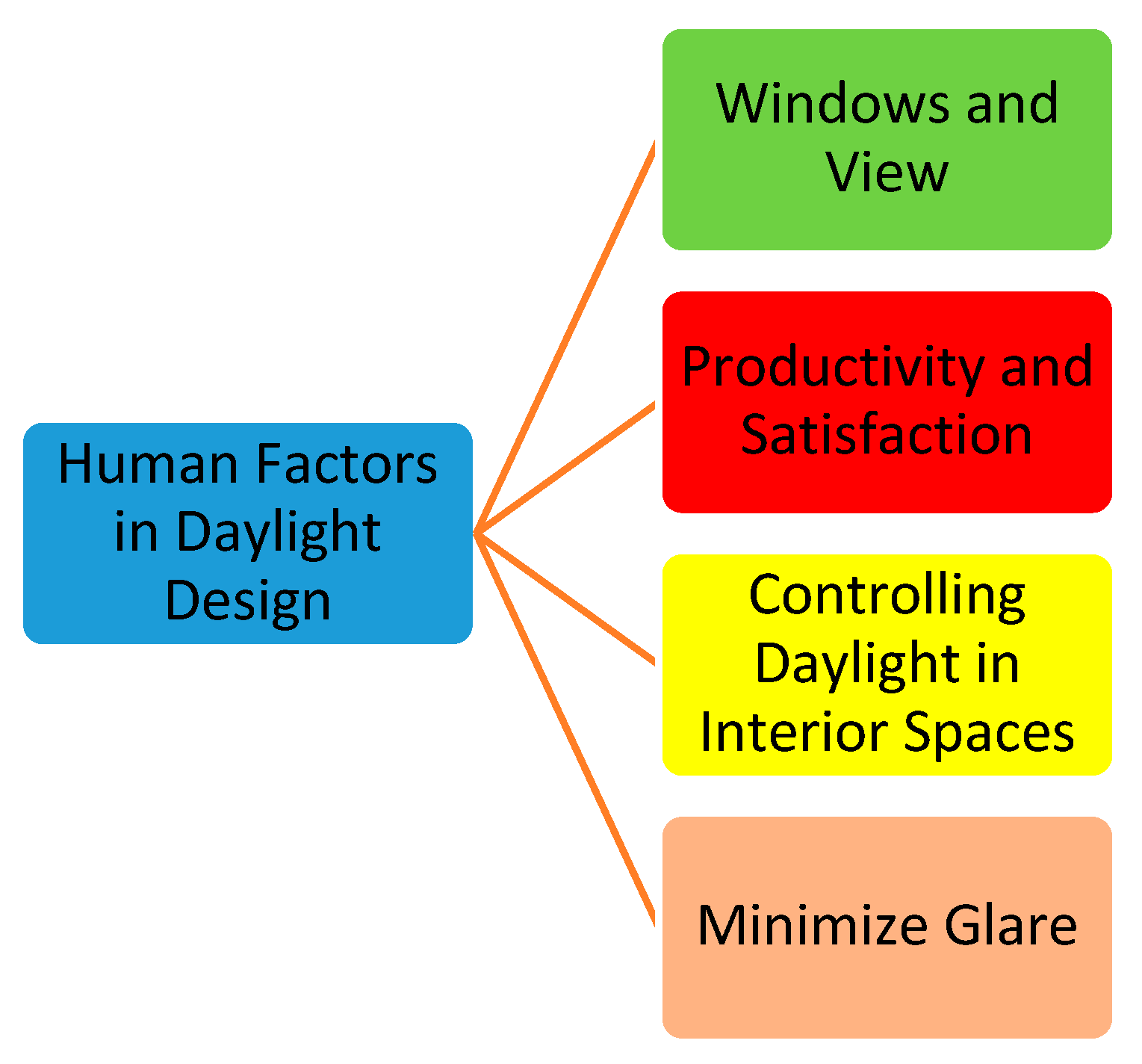
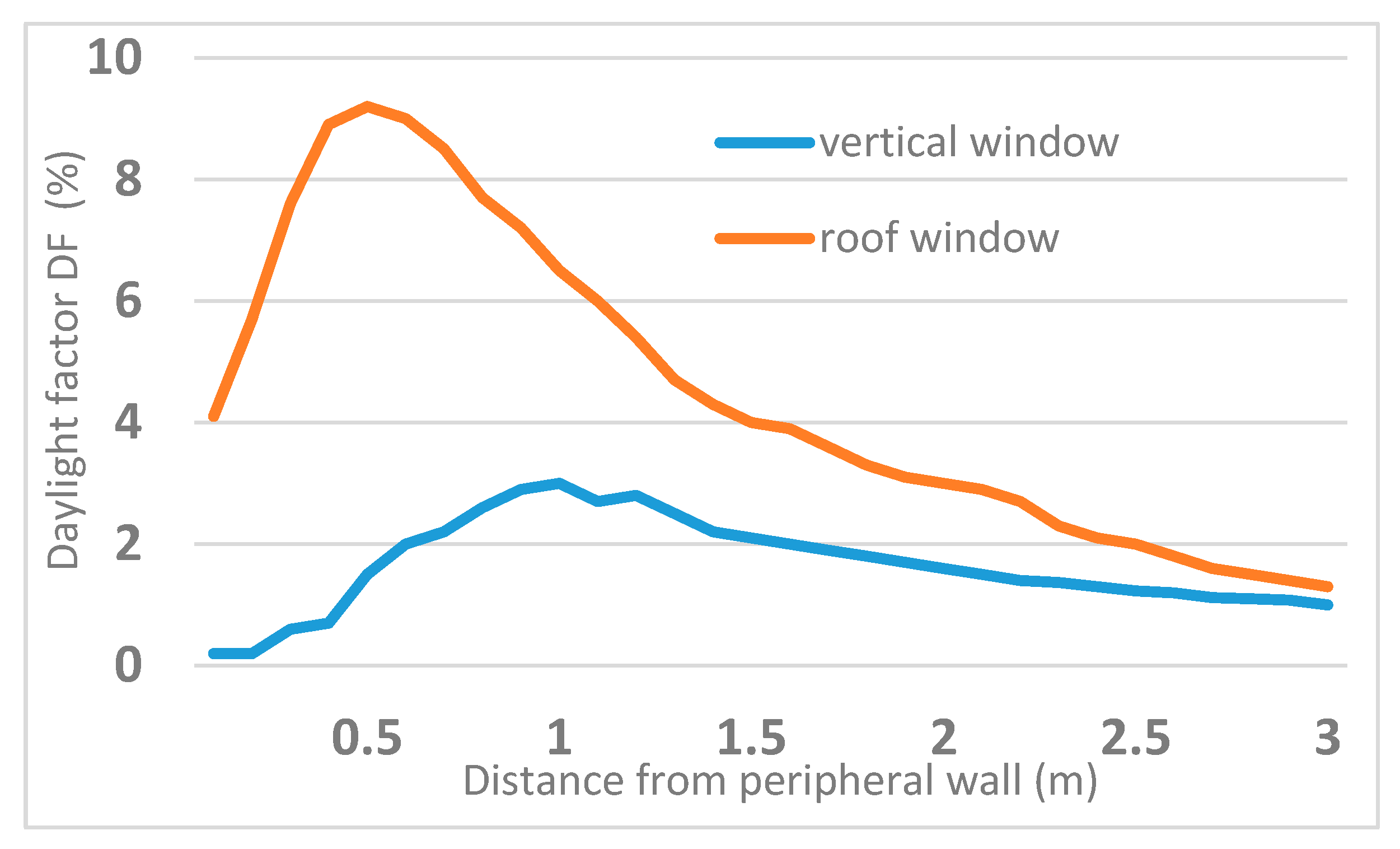
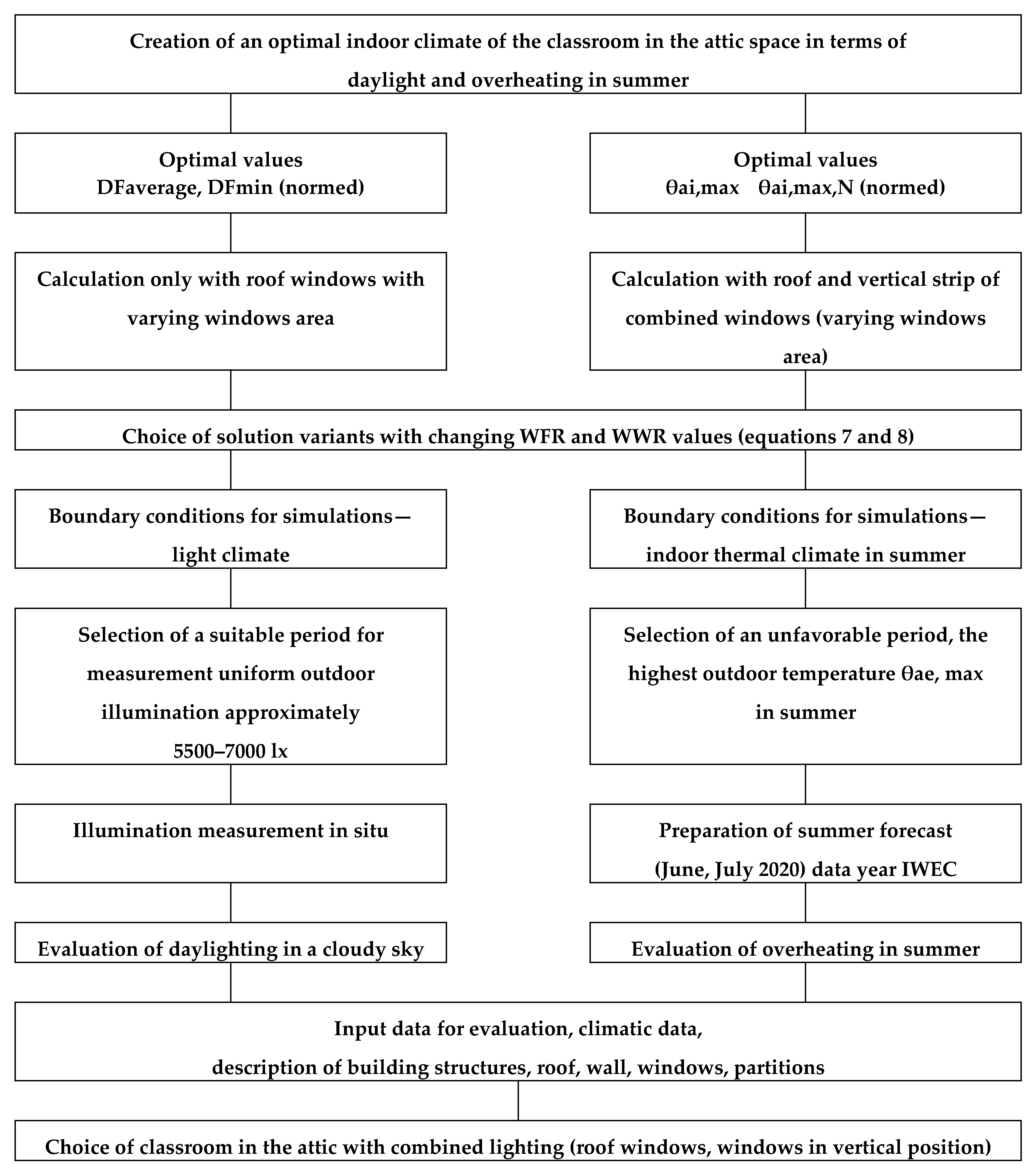
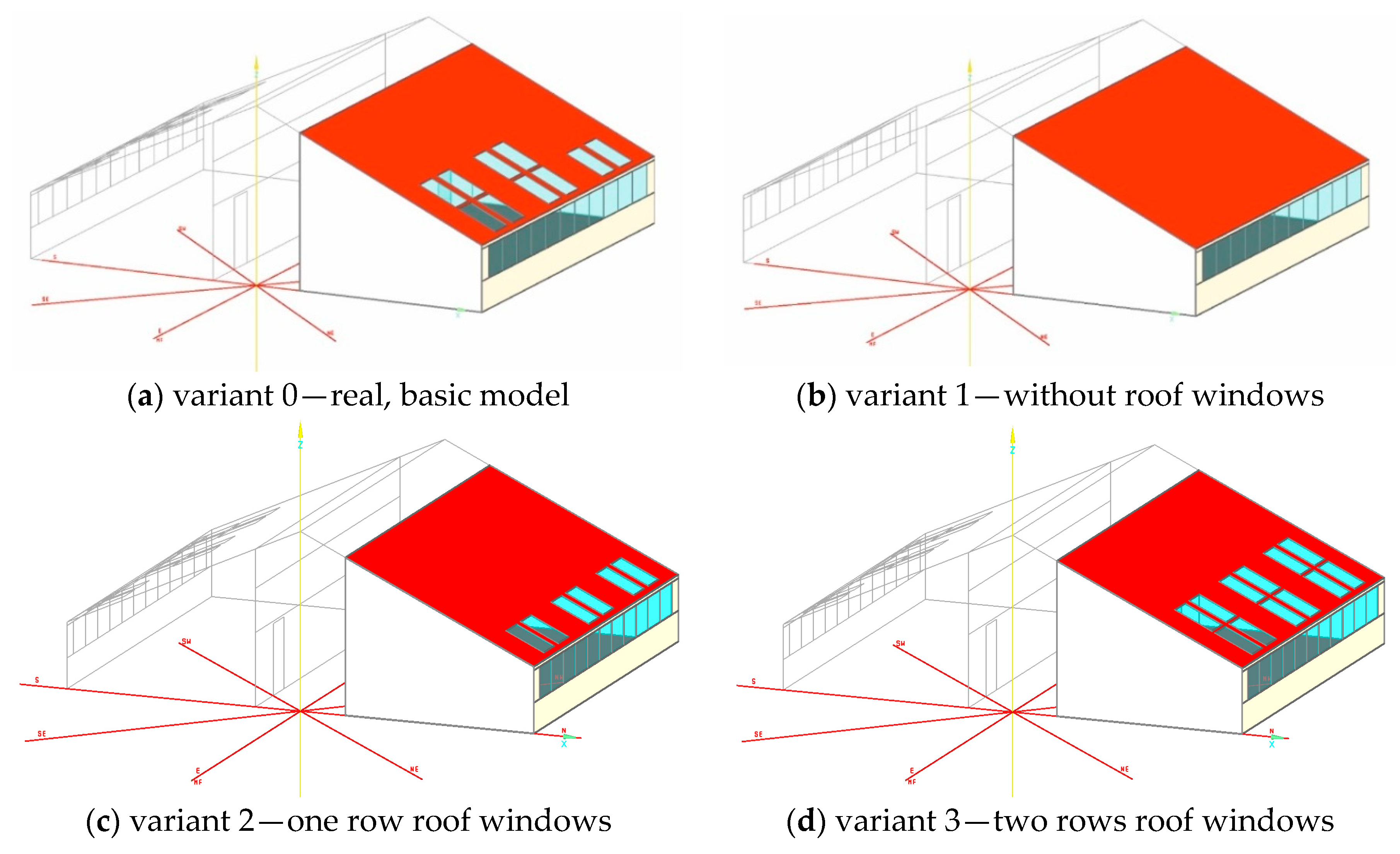

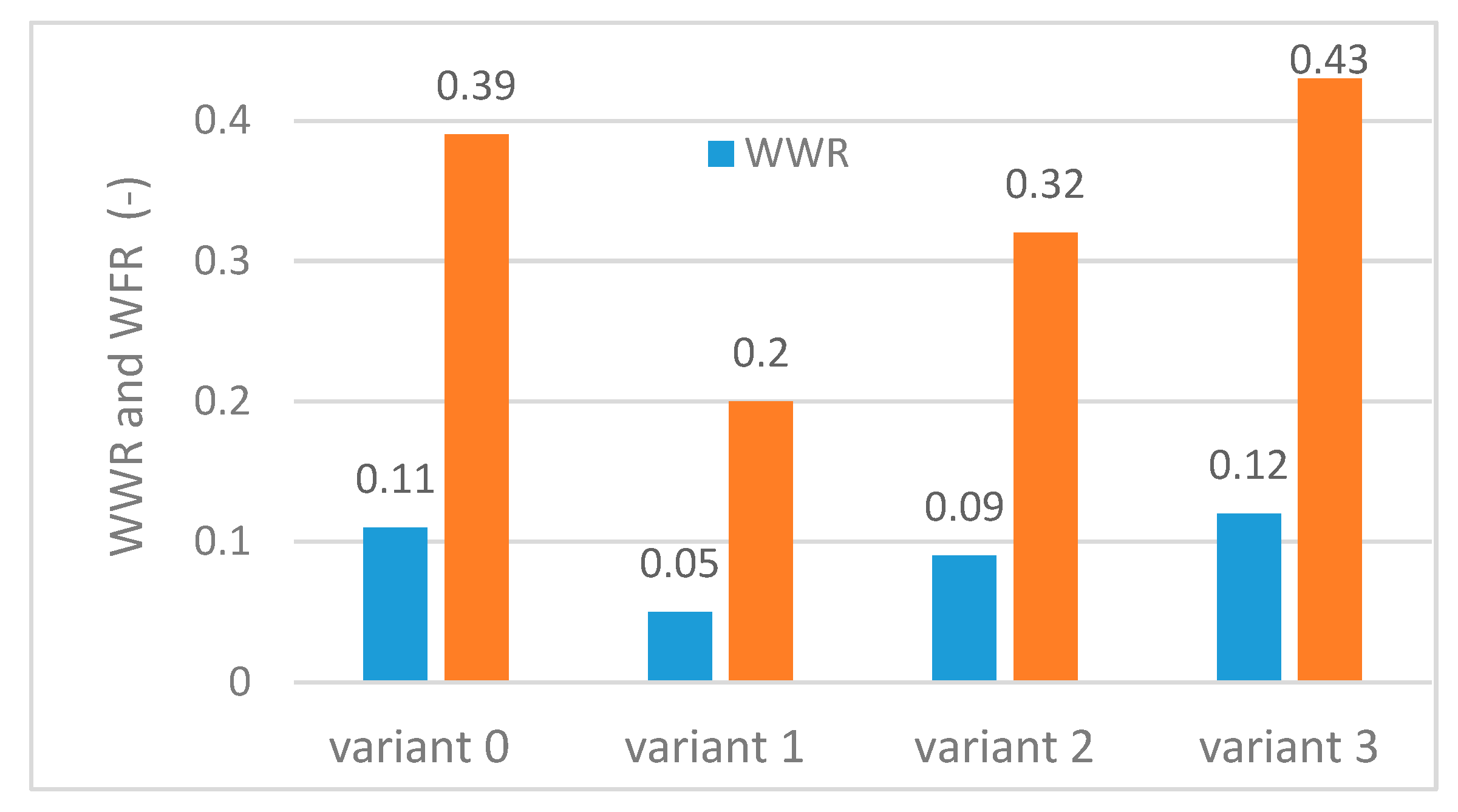
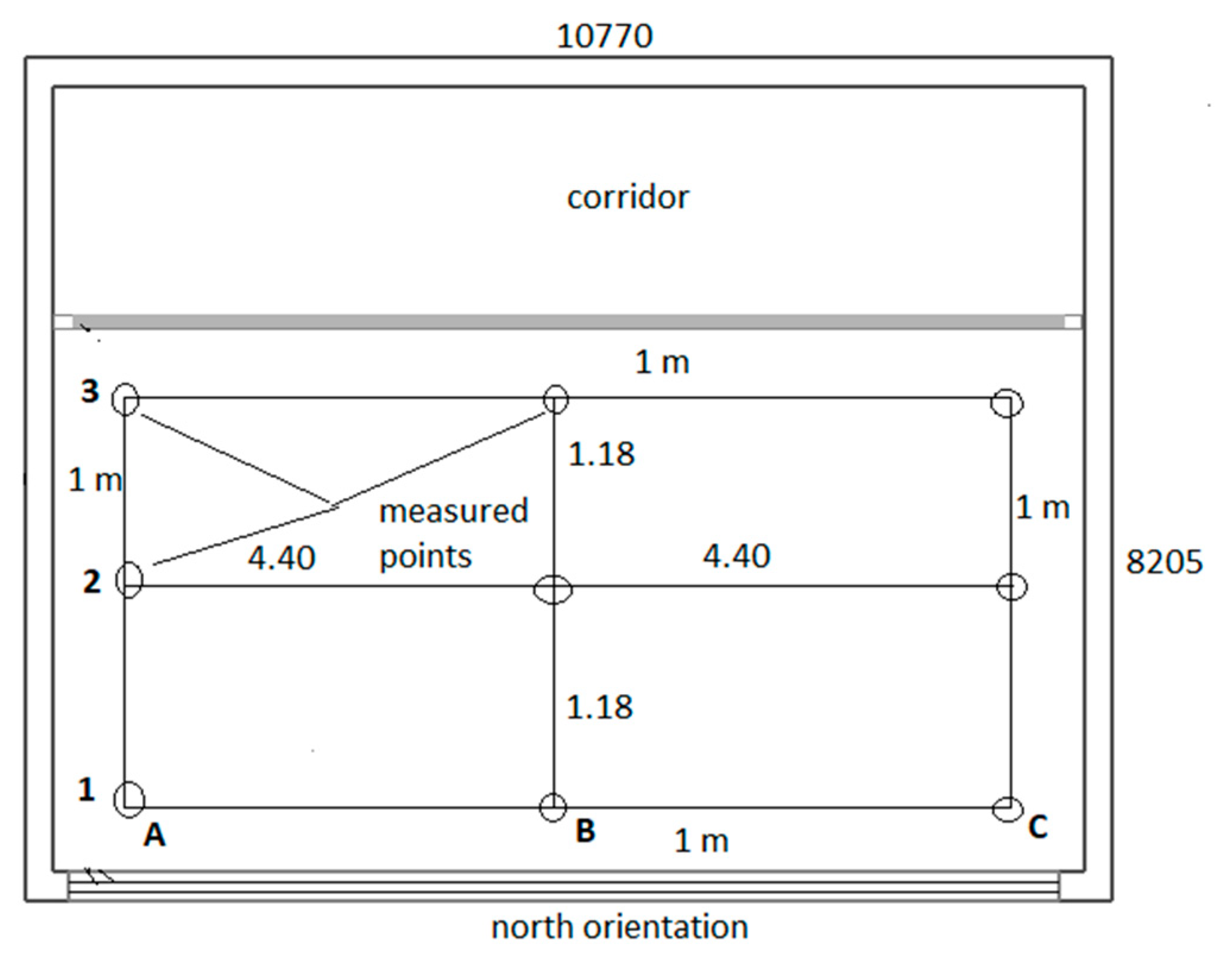
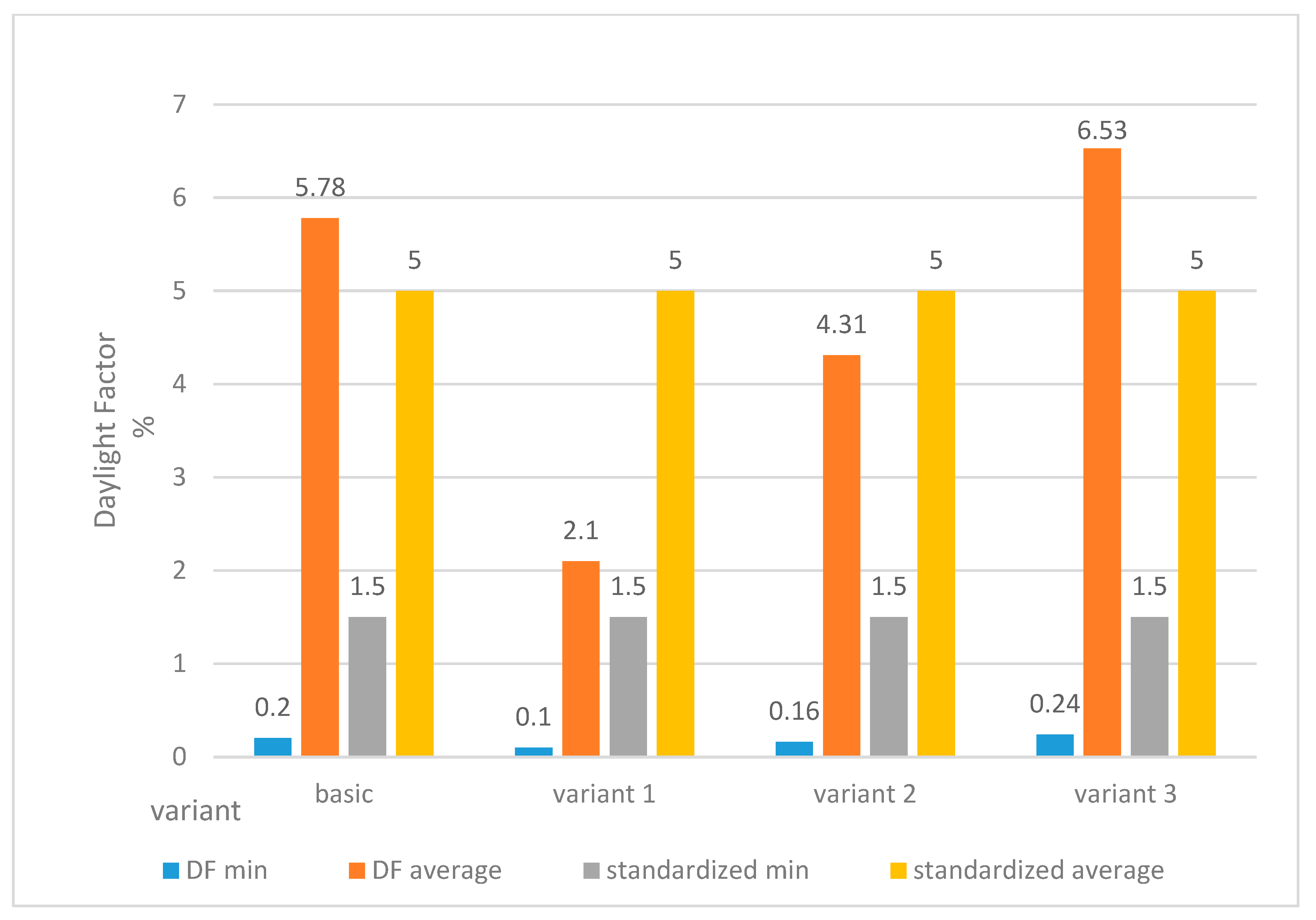

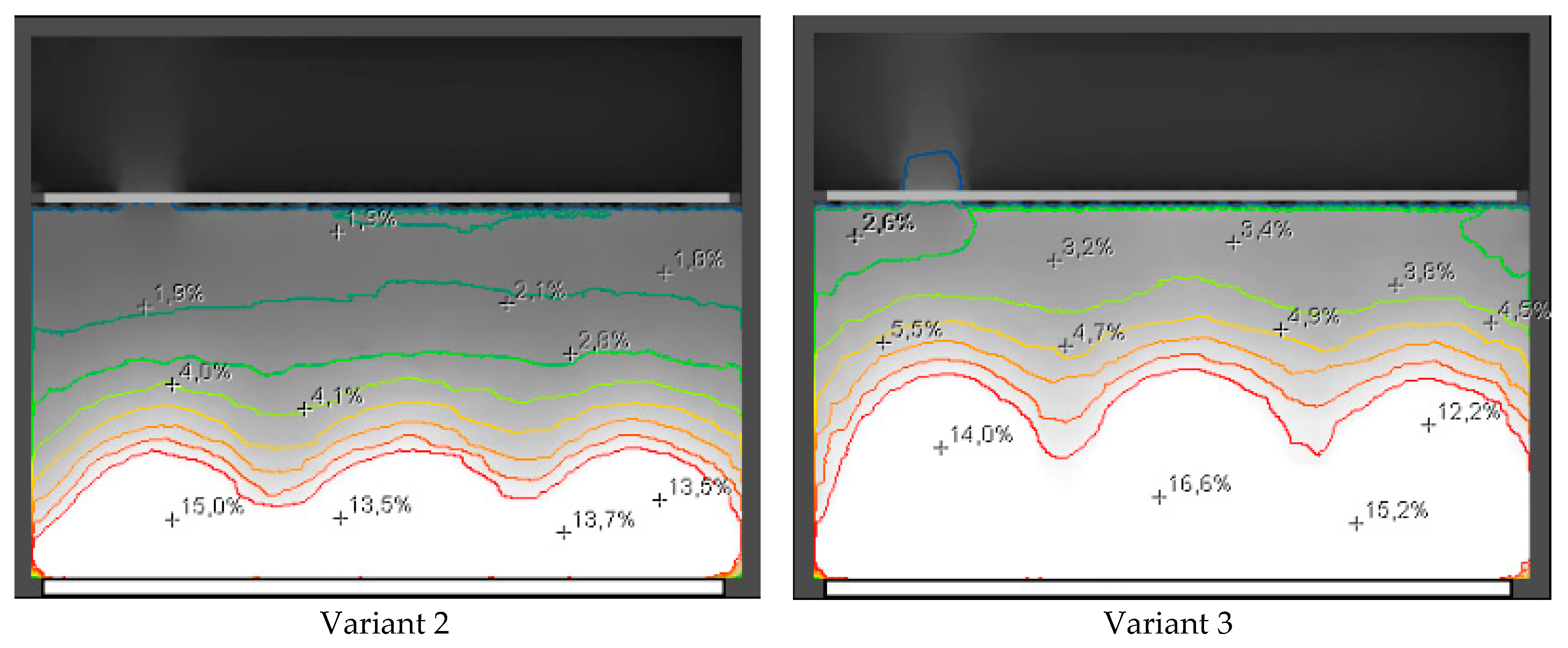
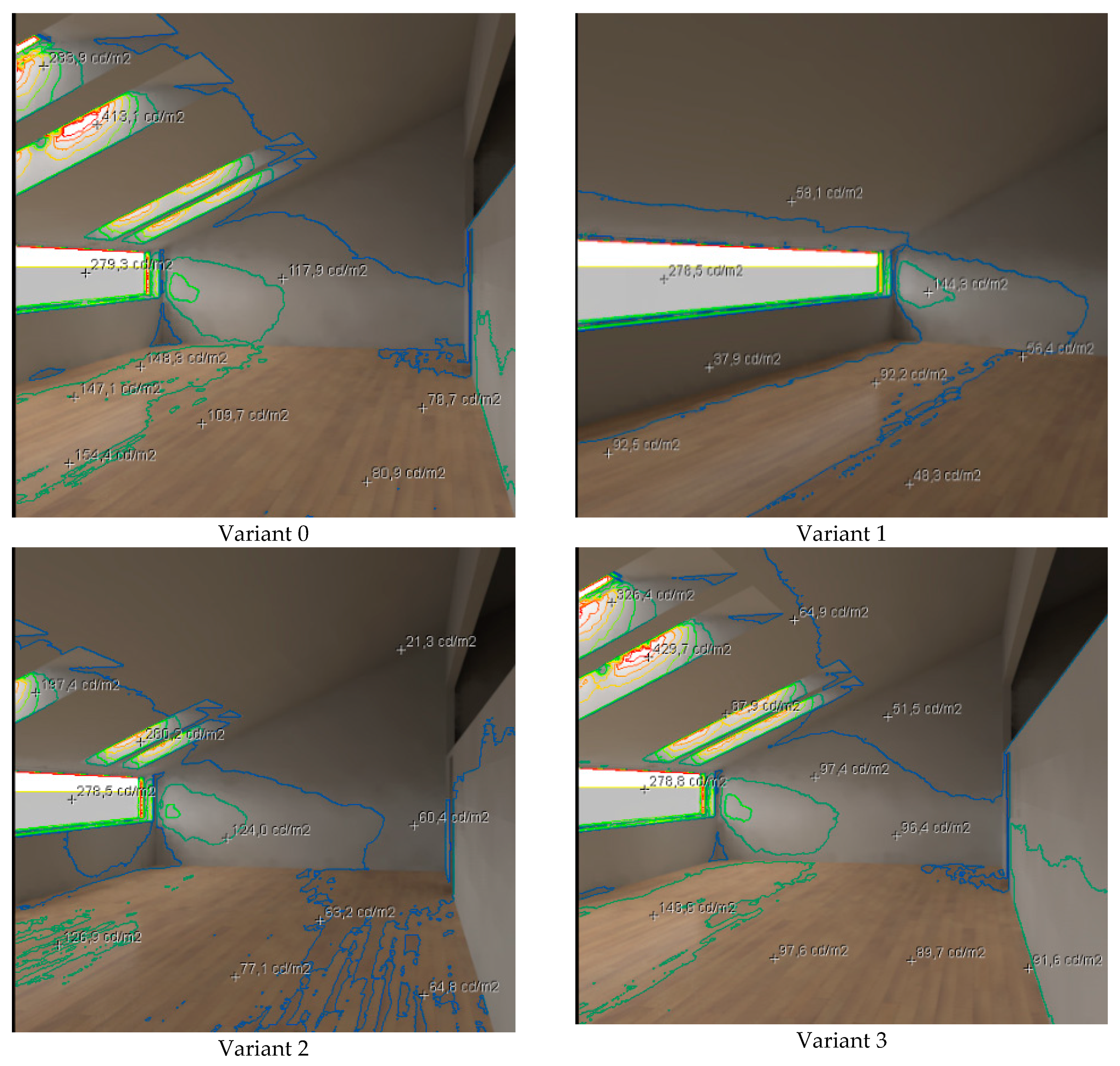
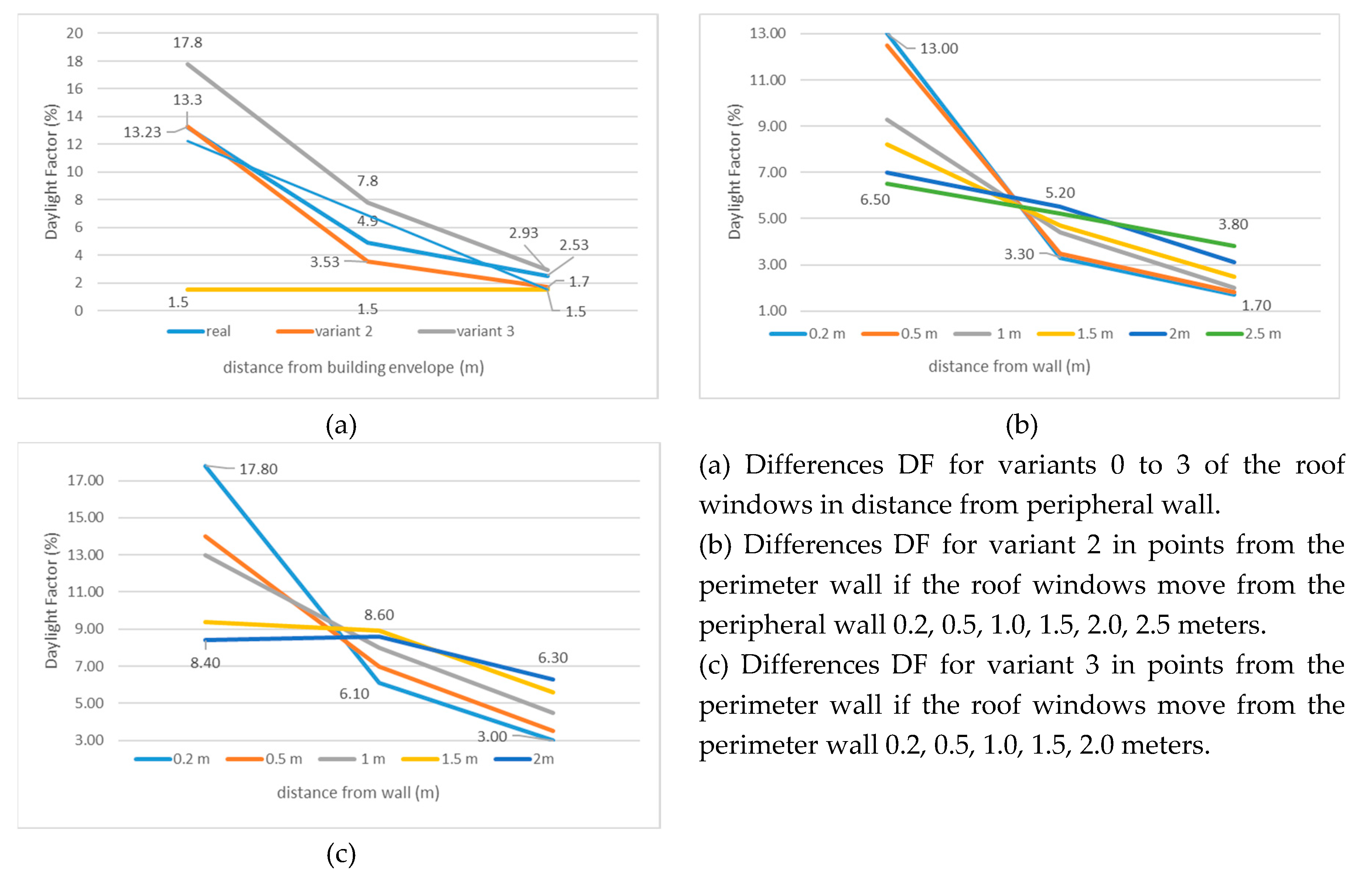

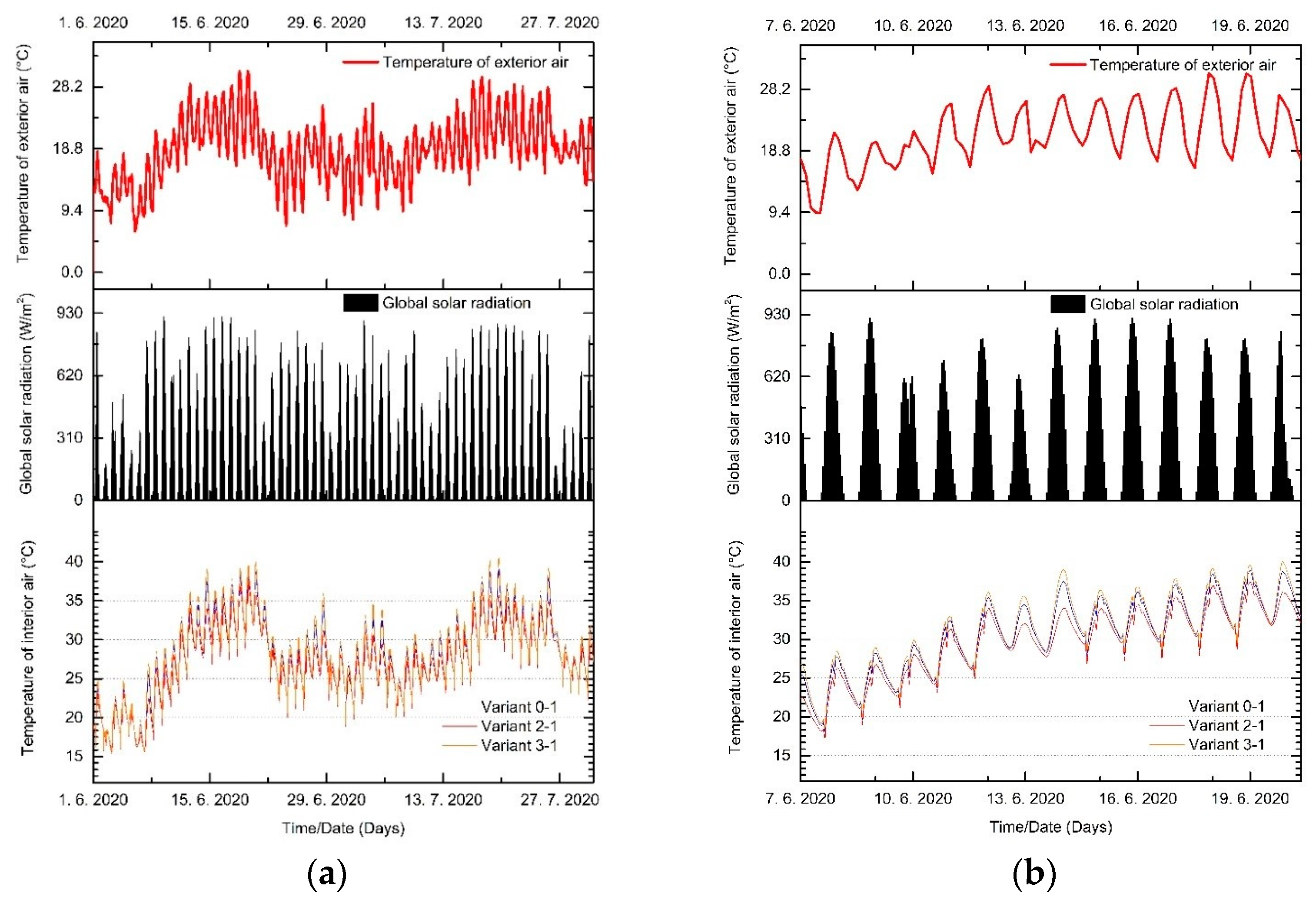

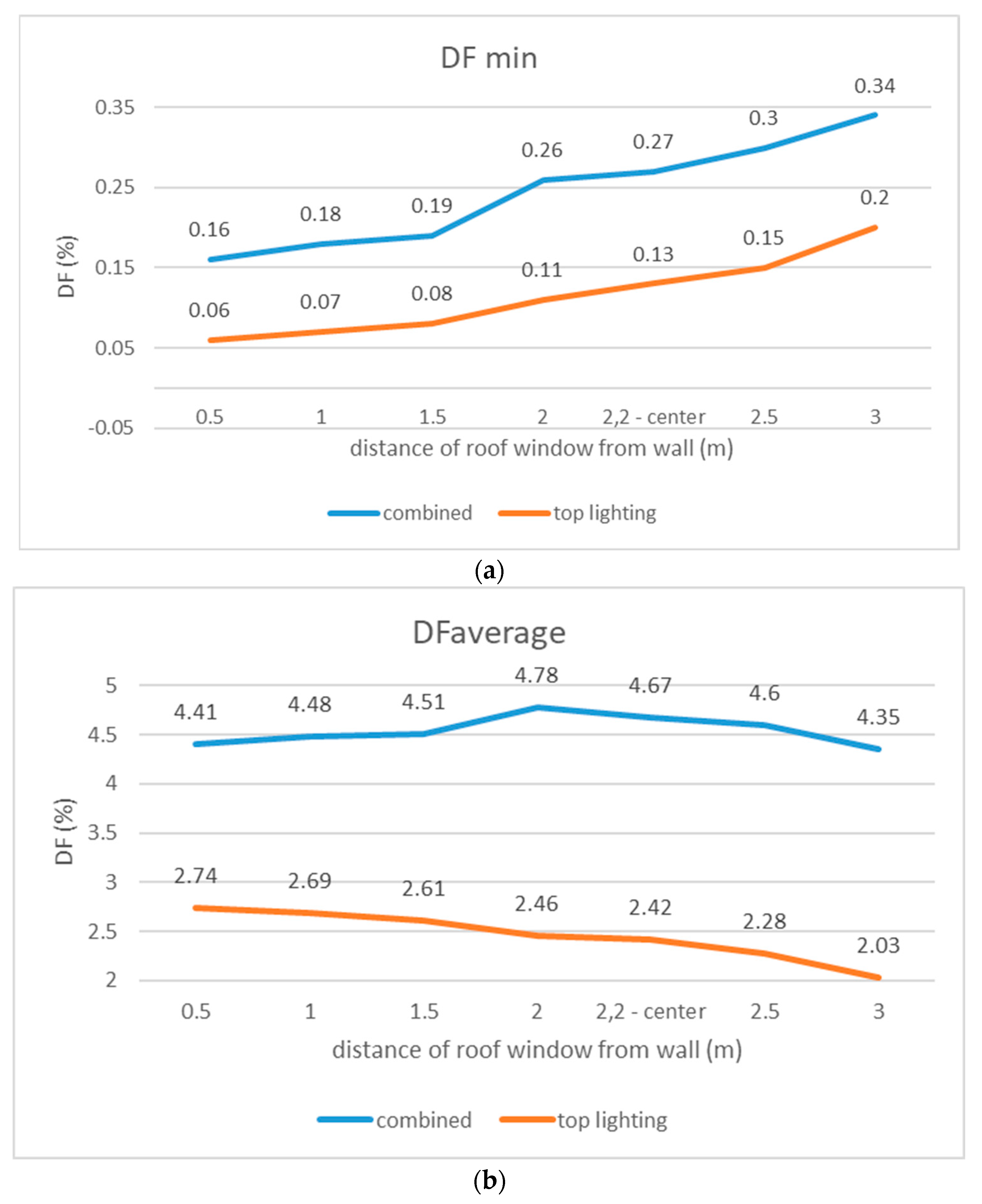
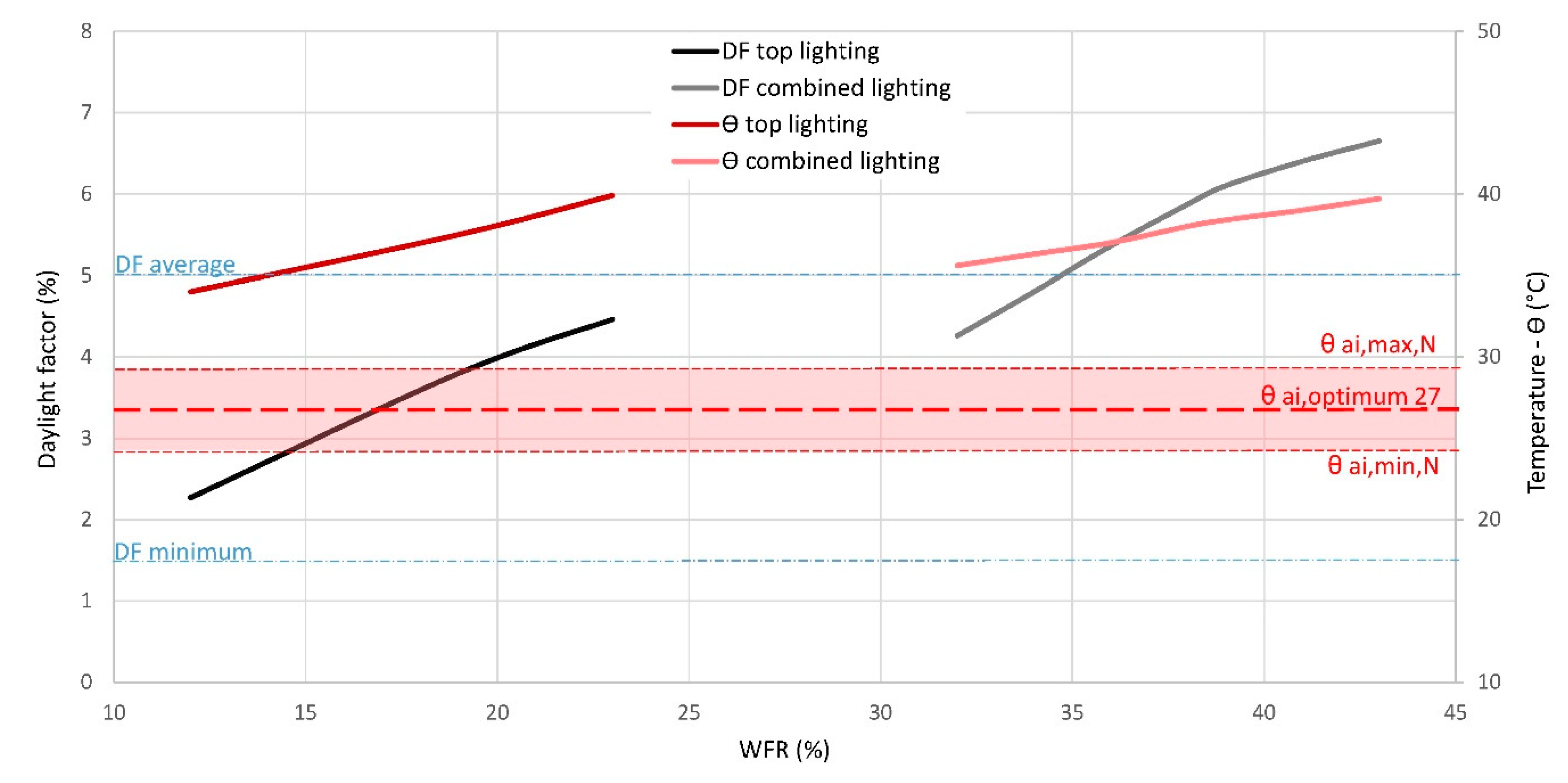
| Area (m2) Side Windows | Area (m2) Roof Lights | Area (m2) Windows (Side + Roof) | Area (m2) Wall | WWR (%) | WFR (%) | |
|---|---|---|---|---|---|---|
| Variant 0 | 9.3 | 9.20 | 18.5 | 171 | 11 | 39 |
| Variant 1 | 9.3 | - | 9.3 | 171 | 5 | 20 |
| Variant 2 | 9.3 | 5.50 | 14.8 | 171 | 9 | 32 |
| Variant 3 | 9.3 | 11.0 | 20.3 | 171 | 12 | 43 |
| Daylight Factor (%)—Measured Values in the Points | ||||
| Point | 1 | 2 | 3 | U0 (-) |
| A | 12.2 | 5.4 | 2.3 | |
| B | 12.7 | 5.0 | 2.8 | |
| C | 10.6 | 3.1 | 1.8 | |
| 0.29 | ||||
| Daylight Factor (%)—Simulated Values in the Points Validation—According to Boundary Conditions Obtained from the Measurement | ||||
| 1 | 2 | 3 | U0 (-) | |
| A | 12.3 | 4.9 | 2.0 | |
| B | 12.1 | 4.7 | 2.5 | |
| C | 9.7 | 2.8 | 1.5 | |
| 0.26 | ||||
| DF | DFmin (%) | DFmax (%) | DFaverage (%) | U0 (-) |
|---|---|---|---|---|
| Variant 0 | 50 | 47 | 64 | −67 |
| Variant 1 | primary | primary | primary | primary |
| Variant 2 | 38 | 41 | 51 | −25 |
| Variant 3 | 58 | 48 | 68 | −25 |
| Nr | Material/Layer (from Outside to Inside) | ρ (kg/m³) | c (J/kgK) | λ (W/mK) | Thickness (m) |
|---|---|---|---|---|---|
| 1 | Cement lime Plaster | 2000 | 850 | 1.2 | 0.02 |
| 2 | Solid Brick Masonry | 1900 | 850 | 0.6 | 0.45 |
| 3 | Mineral Insulation Board | 115 | 850 | 0.043 | 0.1 |
| 4 | Air Layer 50 mm | 1.3 | 1000 | 0.28 | 0.05 |
| 5 | Gypsum Board | 850 | 850 | 0.2 | 0.013 |
| Nr | Material/Layer (from Outside to Inside) | ρ (kg/m³) | c (J/kgK) | λ (W/mK) | Thickness (m) |
|---|---|---|---|---|---|
| 1 | Roofing | 2400 | 1000 | 0.5 | 0.0001 |
| 2 | Air Layer 100 mm Low ventilated | 1.3 | 1000 | 0.59 | 0.1 |
| 3 | Mineral Insulation Board | 113 | 850 | 0.040 | 0.18 |
| 4 | Vapour retarder | 130 | 2300 | 2.3 | 0.0001 |
| 5 | Air Layer 50 mm | 1.3 | 1000 | 0.28 | 0.05 |
| 6 | Gypsum Board | 850 | 850 | 0.2 | 0.013 |
| Nr | Material/Layer (from Outside to Inside) | ρ (kg/m³) | c (J/kgK) | λ (W/mK) | Thickness (m) |
|---|---|---|---|---|---|
| 1 | Cement lime Plaster | 2000 | 850 | 1.2 | 0.01 |
| 2 | Steel-Concrete slab | 2300 | 850 | 1.6 | 0.25 |
| 3 | Mineral Insulation Board | 115 | 850 | 0.043 | 0.06 |
| 4 | Air Layer 70 mm | 1.3 | 1000 | 0.4 | 0.07 |
| 5 | Oriented Strand Board | 630 | 1400 | 0.13 | 0.02 |
| 6 | Oriented Strand Board | 630 | 1400 | 0.13 | 0.02 |
| Nr | Material/Layer (from Outside to Inside) | ρ (kg/m³) | c (J/kgK) | λ (W/mK) | Thickness (m) |
|---|---|---|---|---|---|
| 1 | Gypsum Board | 850 | 850 | 0.2 | 0.013 |
| 2 | Air Layer 120 mm | 1.3 | 1000 | 0.723 | 0.12 |
| 3 | Mineral Insulation Board | 115 | 850 | 0.043 | 0.04 |
| 4 | Gypsum Board | 850 | 850 | 0.2 | 0.013 |
© 2020 by the authors. Licensee MDPI, Basel, Switzerland. This article is an open access article distributed under the terms and conditions of the Creative Commons Attribution (CC BY) license (http://creativecommons.org/licenses/by/4.0/).
Share and Cite
Dolnikova, E.; Katunsky, D.; Vertal, M.; Zozulak, M. Influence of Roof Windows Area Changes on the Classroom Indoor Climate in the Attic Space: A Case Study. Sustainability 2020, 12, 5046. https://doi.org/10.3390/su12125046
Dolnikova E, Katunsky D, Vertal M, Zozulak M. Influence of Roof Windows Area Changes on the Classroom Indoor Climate in the Attic Space: A Case Study. Sustainability. 2020; 12(12):5046. https://doi.org/10.3390/su12125046
Chicago/Turabian StyleDolnikova, Erika, Dusan Katunsky, Marian Vertal, and Marek Zozulak. 2020. "Influence of Roof Windows Area Changes on the Classroom Indoor Climate in the Attic Space: A Case Study" Sustainability 12, no. 12: 5046. https://doi.org/10.3390/su12125046
APA StyleDolnikova, E., Katunsky, D., Vertal, M., & Zozulak, M. (2020). Influence of Roof Windows Area Changes on the Classroom Indoor Climate in the Attic Space: A Case Study. Sustainability, 12(12), 5046. https://doi.org/10.3390/su12125046






